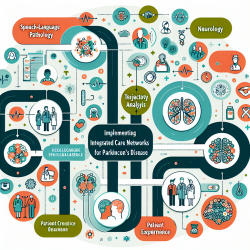Introduction
The complexity of Parkinson's Disease (PD) care necessitates a comprehensive approach that integrates both medical and social support systems. The recent study, "Co-designing an Integrated Care Network With People Living With Parkinson’s Disease: From Patients’ Narratives to Trajectory Analysis," offers valuable insights into designing such networks. This blog will explore how practitioners can leverage these findings to enhance care delivery for PD patients.
Understanding Patient Trajectories
The study identifies three primary trajectories experienced by PD patients: the "unpredictable," "situated," and "demanding" trajectories. These trajectories highlight the diverse and evolving needs of patients, emphasizing the necessity for tailored care strategies.
- Unpredictable Trajectory: Characterized by uncertainty and emotional impact, this trajectory is common among newly diagnosed patients. It underscores the need for immediate access to reliable information and psychological support.
- Situated Trajectory: Patients in this category experience varied care pathways influenced by social support and disease stability. The focus here is on care coordination and community linkages.
- Demanding Trajectory: This involves patients with poorly controlled symptoms or rapid disease progression, highlighting the need for intensive support and resource accessibility.
Implementing Integrated Care Networks
To effectively support these trajectories, integrated care networks must be patient-centered, adaptable, and resource-efficient. Here are key strategies for implementation:
- Personalized Care Plans: Develop individualized care pathways that address the specific needs of each trajectory. This includes regular assessments and adjustments to treatment plans.
- Enhanced Communication: Establish robust communication channels between patients, care partners, and healthcare providers to ensure timely information exchange and support.
- Community Resource Integration: Facilitate access to local services and support groups, ensuring that patients and their families are well-connected to necessary resources.
- Proactive Monitoring: Implement systems for continuous monitoring of patient health to anticipate and prevent complications, thereby improving overall quality of life.
Encouraging Further Research
While this study provides a foundational understanding of patient trajectories, further research is essential to refine integrated care models. Practitioners are encouraged to engage in participatory design workshops and collaborate with researchers to co-create solutions that address the unique challenges faced by PD patients.
Conclusion
By adopting a trajectory-informed approach, practitioners can significantly enhance the quality of care for PD patients. The integration of medical and social care, supported by continuous research and collaboration, promises to improve patient outcomes and experiences.
To read the original research paper, please follow this link: Co-designing an Integrated Care Network With People Living With Parkinson’s Disease: From Patients’ Narratives to Trajectory Analysis.










